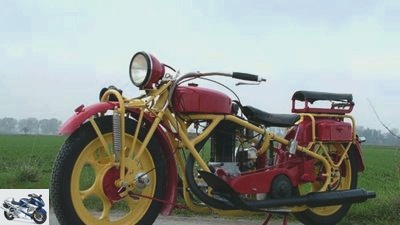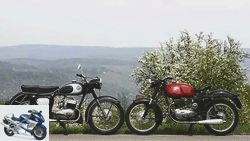Menus

Noll
On the move: Bohemia
Caution, excess length!
Content of
Length runs. Length impressed. And length makes you famous. No matter how short-lived Mr. Liebisch’s ideas were otherwise.
Noll
Bohemia short version.
Discussions about the extravagant vehicles of Albin Liebisch from Schonlinde in Northern Bohemia (today: Krásná Lípa, in a foothills of the Czech Republic between Dresden and Zittau) are as old as the motorcycles themselves. Colorfully painted two-wheelers were also built elsewhere in the mid-1920s, but the sheer size of a Bohmerland – even the one shown here "Normal length" over three meters – made them far more prominent than their distribution would suggest. Besides the "normal" Liebisch built a long version that could accommodate three people in a row on the bench and the single seat above the rear wheel.
Ride with such a thing? Asking a sumo wrestler to play a Viennese waltz seems the easier exercise. One thing at a time, carefully working through the checklist for pre-war motorcycles: Open the ignition timing with a lever on the right end of the handlebar "late" so that the driver and ankle do not suffer a kickback. Open the brass taps for oil and fuel. Flood carburetor. Raise the exhaust valve with the decompression lever. Where is he now again? Ah, on the rocker arm housing! Now, at the same time, push through the kick starter with momentum and full body effort and release the deco lever again. Fortunately, the main stand is just as expansive and stable as the rest of Bohmerland, so that this exercise can be carried out without tilting.
No mistake: a single cylinder with 600 cubic meters is screwed directly to the frame between the driver’s legs. The vibrations that the engine introduces into the chassis are correspondingly eliminated. The two rocker arms of the valve train run without encapsulation, which sooner or later decorates the driver’s clothing with oil mist. The raised running boards, on the other hand, seem almost paradoxical, which are obviously intended to protect the shoes from splashes of dirt. Once you have come to terms with this concept, you will sit extremely comfortably on the wide leather saddle.
Now turn the throttle grip, shake the power out of your wrist – no indication: accelerating works with another lever on the right end of the handlebar, which however remains in its position after releasing – a matter of getting used to, but feasible. The extremely long-stroke engine – from a 79.8 mm bore and 120 mm stroke results in 600 cm³ – develops full torque even in the lower speed range, but naturally nourishes respect for high speeds. The transmission provides three gears, and you don’t want to turn any of them out. Shifting gears early and taking a leisurely pace are much more fun. The rigid rear and the front wheel suspension delegate some damping tasks to the balloon tires, which do their best. And at least the short version is more manageable than its appearance suggests. In the 20s and 30s there were two-wheelers with a shorter wheelbase, which were by no means more manoeuvrable, even if the Bohmerland cannot hide their size and mass.
Behind such an exotic driving experience is unusual technology and an idiosyncratic, almost stubborn engineer. The main structure of the double-loop frame is bent from a single tube: it runs from the steering head under the engine to the rear axle mount, at the level of the cylinder head past the engine back to the steering head and turns there to a second loop. With its cross struts, this architecture appears as stable as a railway bridge. A pushed short swing arm with adjustable friction dampers guides the front wheel, with a tension spring on the left and right to compensate for unevenness in the roadway.
Instead of the commonly used wire-spoke wheels, Liebisch opted for light-alloy cast wheels, which only found their way into large-scale motorcycle construction 60 years later. Our example has cast stars that are screwed to the rim.
The ohv single cylinder stands in the frame like a watchtower. Its cylinder head with a hemispherical combustion chamber therefore protrudes beyond the frame behind the tank. Liebisch did not follow the fashionable trend towards double port outlets, but stuck to the monoport principle. Holes facilitate the drop-forged connecting rod, the crankshaft rotates in a housing made of cast aluminum. The fuel is conventionally stored in a short 10-liter tank, the 1.5-liter tank for fresh oil lubrication is located to the right of the rear wheel. An oil pump supplies the engine from there. The driver has to lubricate the valve train manually: the oil reaches the rocker arm shafts mounted on roller bearings through holes in the rocker arm housing.

classic
On the move with the BMW WR 750
Ready-to-drive replica
read more
Technical specifications
Initially, the Ultra-Langhuber released 16 hp at 4000 rpm, and in the course of its production time the rated output even rose to 24 hp at 3500 rpm. The manufacturer promised top speeds of 120 to 130 km / h, depending on the model; a racing version should even reach 150 km / h. A major industrialist who was enthusiastic about motorsport gave Liebisch financial independence. So he didn’t have to worry about advertising and sales figures, but was able to access well-preserved materials and ready-made parts beyond any computational reason: Mannesmann pipes for the chassis, gearboxes from Sturmey Archer or Hurth and Bosch-Elektrik.
The downside: Liebisch didn’t care about agents or dealers for his motorcycle. Who a Bohmerland or "Čechie", as it was called in the Czech-speaking areas, it had to be picked up at the factory. Until 1937, Albin Liebisch built around 50 motorcycles a year. Most of the machines went to Northern Bohemia, Saxony and Thuringia, some also to Austria. About 75 of them still exist, a good half in running order. And when they appear, they still stimulate discussions today as they did on the first day.
Technical data Bohmerland short version
Engine: Air-cooled single-cylinder four-stroke engine, two underlying camshafts, two valves, operated via bumpers and rocker arms, bore 79.8 mm, stroke 120 mm, displacement 600 cm³, 16 HP at 4000 rpm, dry sump lubrication, Bing round slide carburetor
Electrical system: Kick starter, Bosch ignition light magnet
Power transmission: Primary drive: chain, multi-plate dry clutch, manual Sturmey-Archer three-speed gearbox, secondary drive: chain
Landing gear: Double loop frame made of tubular steel, front short swing arm with tension springs, rear rigid frame, light alloy cast wheels, tires front and rear 3.25-19, front and rear simplex drum brakes
Measurements and weight: Wheelbase 1475 mm, seat height 650 mm, weight 185 kg, tank capacity 10 liters
Driving performance: Top speed 115 km / h
Construction year: 1930
Manufacturer: Albin Liebisch Motoren & Motorbike construction, Schonlinde, Northern Bohemia

Naked bike
On the move: Gilera B 300, UT TS 252
Music is in the air
read more
Related articles
-
On the move: Harley-Davidson Electra Glide old versus new
Wolf On the move: Harley-Davidson Harley-Davidson Electra Glide old versus new Content from Harley-Davidson is said to bring old technology at modern prices …
-
On the move: BMW R 100 S, Honda CB 900 F Bol d’Or, Moto Guzzi Le Mans I.
fact On the move: Big Bikes of the 70s BMW R 100 S, Honda CB 900 F Bol d’Or, Moto Guzzi Le Mans I Contents of At the change of the decade, MOTORRAD asks …
-
fact On the move: Kawasaki 250TR New classic single-cylinder scrambler from Kawasaki Contents of After the unsuccessful Kawasaki Estrella 250 comes the …
-
On the move: Harley-Davidson XR 1000-XR 1200
fact On the move: Harley-Davidson XR 1000 / XR 1200 Sports spirit Content of Harley-Davidson and sporty motorcycles – despite the Sportster models …
-
Vogt On the move: BSA C11 de Luxe For the sake of simplicity, the content of In addition to sporty gold stars and heavy stews, BSA also had …
-
On the move: the BMW GS conversion by BMW developer Laszlo Peres
Jahn On the move: BMW GS conversion The BMW GS from BMW developer Laszlo Peres Contents of The former BMW developer and terrain specialist Laszlo Peres makes …
-
On the move with Majestic 350 from 1930 and Bimota Tesi 1D-SR from 1992
41 pictures r-photography.info 1/41 picture gallery: Majestic 350 from 1930, Bimota Tesi 1D / SR from 1992. r-photography.info 2/41 The …
-
On the move with Kawasaki GPZ 900 R and Yamaha FJ 1100
fact 39 pictures fact 1/39 Hurry with a while, always slowly with the young horses – sayings like these were definitely not up for debate when the …
-
On the move with the BMW R 100 RS, Kawasaki Z 900 and Moto Guzzi 850 Le Mans
Rivas 39 pictures Arturo Rivas 1/39 The old controversial question of what makes really fast has moved bikers for generations: high performance, good aerodynamics or …
-
On the move with the BMW R 5 and Triumph T 100 Tiger
r-photography.info On the move with BMW R 5 and Triumph T 100 Tiger Greetings to the modern age Contents of the end of gigantic, rugged displacement giants: …